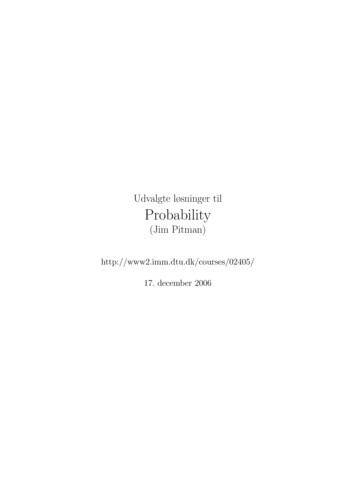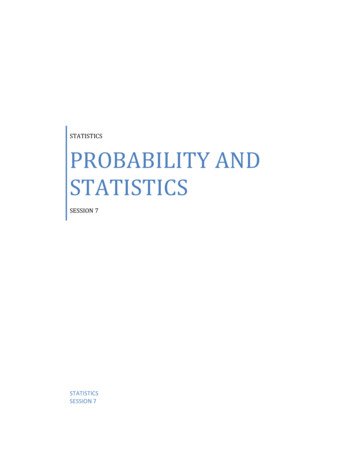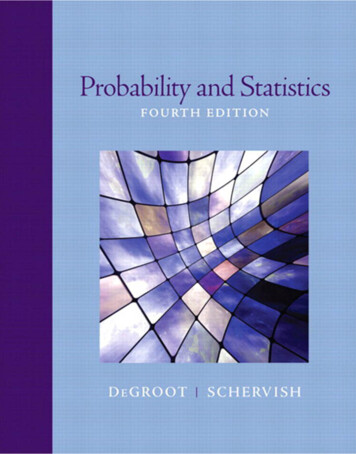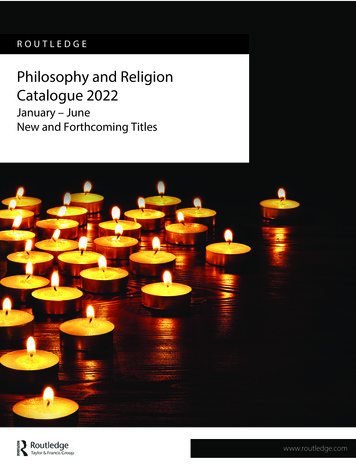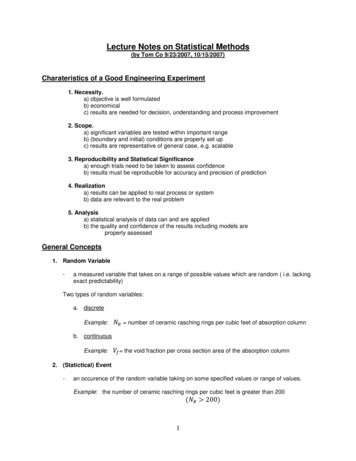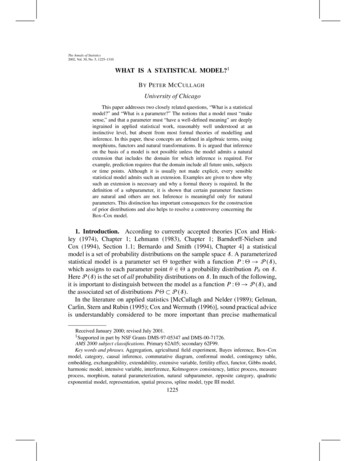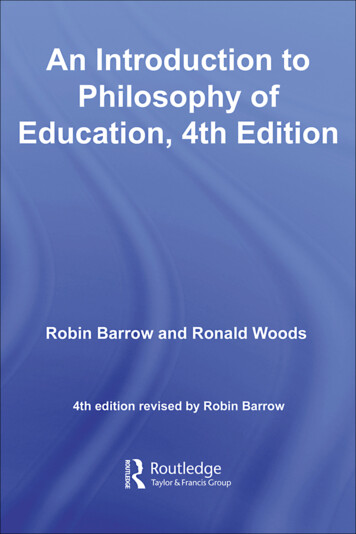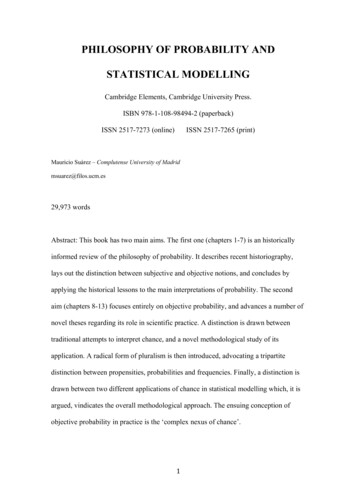
Transcription
PHILOSOPHY OF PROBABILITY ANDSTATISTICAL MODELLINGCambridge Elements, Cambridge University Press.ISBN 978-1-108-98494-2 (paperback)ISSN 2517-7273 (online)ISSN 2517-7265 (print)Mauricio Suárez – Complutense University of Madridmsuarez@filos.ucm.es29,973 wordsAbstract: This book has two main aims. The first one (chapters 1-7) is an historicallyinformed review of the philosophy of probability. It describes recent historiography,lays out the distinction between subjective and objective notions, and concludes byapplying the historical lessons to the main interpretations of probability. The secondaim (chapters 8-13) focuses entirely on objective probability, and advances a number ofnovel theses regarding its role in scientific practice. A distinction is drawn betweentraditional attempts to interpret chance, and a novel methodological study of itsapplication. A radical form of pluralism is then introduced, advocating a tripartitedistinction between propensities, probabilities and frequencies. Finally, a distinction isdrawn between two different applications of chance in statistical modelling which, it isargued, vindicates the overall methodological approach. The ensuing conception ofobjective probability in practice is the ‘complex nexus of chance’.1
Contents:AcknowledgementsIntroduction1. The Archaeology of Probability2. The Classical Interpretation: Equipossibility3. The Logical Interpretation: Indifference4. The Subjective Interpretation: Credence5. The Reality of Chance: Empiricism and Pragmatism6. The Frequency Interpretation: Actual and Hypothetical Frequencies7. The Propensity Interpretation: Single Case and Long Run8. Interpreting and Applying Objective Probability9. The Explanatory Argument and Ontology10. Metaphysical Pluralism: The Tripartite Conception11. Methodological Pragmatism: The ‘Complex Nexus of Chance’12. Two Types of Statistical Modelling13. Towards a Methodology of Chance ExplanationReferences2
AcknowledgementsFor comments I want to thank Hernán Bobadilla, Carl Hoefer, Michael Strevens, andaudiences at Paris (IHPST Panthéon-Sorbonne, 2017 and 2018), Turin (conference onthe models of explanation in 2018), and Pittsburgh (HPS annual lecture series 2018-9),as well as two referees for Cambridge University Press. My thanks also to JacobStegenga, Robert Northcott, and Annie Toynbee, at Cambridge University Press, fortheir editorial encouragement and advice. Financial support is acknowledged from theEuropean Commission (Marie Curie grant project 329430 (FP7-PEOPLE-2012-IEF),and the Spanish government projects FFI2014-57064-P and PGC2018-099423-B-100.3
IntroductionHumans have been thinking in probabilistic terms since antiquity. They havebeen thinking systematically, and philosophizing, about probability since theseventeenth century. And they have been formalizing probability since the end of thenineteenth century. The twentieth century saw intense philosophical work done oninterpreting probability, in a sort of attempt to find out its essence. The twenty-firstcentury, I argue, will bring a focus on more practical endeavours, concerning mainly themethodologies of data analysis and statistical modelling. The essence of probability, itturns out, lies in the diversity of its uses. So, the methodological study of the use ofprobability is what brings humans closer to a comprehensive understanding of itsnature.These and other ideas expounded in this book developed out of a Marie Curieproject on probability and propensities that I carried out at the Institute of Philosophy ofthe School of Advanced Study, at London University, during 2013-2015. I came out ofthat project with the distinct impression that the study of practice was of primaryimportance; and that much philosophy of probability is still to come to terms with it.This book is my first attempt at the bare bones of a new research programme into themethodology of statistical modelling. Most of the book is devoted to justifying thismethodology – on the grounds of practical involvement with the scientific modellingpractice but, also, I argue, on account of the limitations of the traditional interpretativeapproaches to the topic.4
Thus, the first half of the book (Chapters 1-7) is entirely a state-of-the-art reviewof the historiography of probability, and its ensuing impact upon the interpretativeendeavour. This is fitting for a Cambridge Elements volume, which allows for a profusesetting of the stage. And it is anyway needed in order to understand why nothing otherthan a study of the practice of statistical model building will do for a full understandingof objective probability. I first explore (in Chapter 1) the dual character of the notion ofprobability from its inception; the subjective and objective aspects of probability thatare essential to any understanding the concept. The twentieth century brought in severalinterpretations of probability. But one way or another, they all aim to reduce probabilityto either subjective or objective elements, thus doing away with the duality; and oneway or another they all fail, precisely because they do away with the duality. In theremaining Chapters in this half of the book, I analyse in detail the many objectionsagainst both the main subjective interpretations (the logical and personalist or Bayesianinterpretations), and the main objective interpretations (the frequency and propensityinterpretations). To make most of these interpretations work, and overcome theobjections, demands some acknowledgment of the complex duality of probability. Thisis by now widely accepted, and the book first reviews the roots and consequences ofpluralism about objective probability.The second half of the book (Chapters 8-13) then centres upon the objectiveaspects of probability, but now without any pretence of a reduction of the wholeconcept. The discussion is focused entirely on objective probability, and it containsmost of the original material. I advance a number of novel theses, which I defend invarious original ways, as well as proposing a number of new avenues for research. Thestarting point is pluralist, and it accepts the duality in so far as it argues that there are5
important matters of judgement in the selection of crucial aspects of the application ofobjective probability in practice. Here, the critical distinction, advanced in Chapters 8and 9, is between the traditional project to merely interpret probability, and a distinctproject to study the application of probability. On the other hand, I go considerablybeyond the pluralism defended in the first half of the book and, in Chapter 10, Iembrace novel forms of pluralism and pragmatism regarding objective probability.The central idea of the second half, which also informs the book as a whole, andlooms large through most of its discussions is what I have elsewhere called the‘tripartite conception’ of objective probability (Suárez, 2017a). This is the idea that thefailure to reduce chance to either propensity or frequency ought to lead to theacceptance of all three concepts as distinct, insufficient yet necessary, parts of the largernotion of ‘objective probability’. This tripartite conception is introduced in Chapter 10,which also assesses the role of judgement and various subjective components. Thefollowing Chapters 11, 12 and 13 are then devoted to modelling methodology, and theapplication of the tripartite conception in statistical modelling practice in particular, inwhat I call the ‘complex nexus of chance’ (CNC). The thought running through theseChapters is new and radical: objective probability is constituted by a thick array ofinterlinked practices in its application; these are practices that essentially involve thethree distinct notions pointed to above; and since none of these notions is theoreticallyreducible to any combination or set of the other two, this means that the overallmethodology remains unavoidably ‘complex’. There is no philosophical theory that mayexplicate fully the concept of objective probability, or chance, by reducing thiscomplexity, and this already sheds light on the limitations of the interpretationsreviewed in the book’s first half.6
What’s more, the second half of the book also continues to illustrate thefundamental duality of probability unearthed in the historiographical material reviewedin the first seven Chapters. It does so in three different yet interrelated ways. First of all,it leaves open that subjective elements may come into the nature of the single-casechances that make up the tripartite conception. Secondly, confirmation theory comesinto the assessment of evidence for and against different models. And, finally, there areirreducible subjective judgements involved in the pragmatist methodology advocated inthe later chapters. For instance, in Chapter 11 I argue that choosing the appropriateparametrization of the phenomenon to be modelled is a critical part; and there is noalgorithm or automatic procedure to do this – the choice of free parameters is subject tosome fundamentally ‘subjective’ estimate of what is most appropriate in the context forthe purposes of the model at hand. Once again, the ‘subjective’ and the ‘objective’aspects of probability meet in fundamental ways (see (Gelman and Hennig, 2017), aswell as my response (Suárez, 2017b) for an account of such merge in practice). Anotherrelated sense of subjectivism in statistical modelling is sometimes referred to as the ‘artof statistical modelling’ and concerns the choice of a correlative outcome or attributespace. There is nothing arbitrary about this ‘subjectivity’ though, since it answersprecisely to specific pragmatic constraints: It is a highly contextual and purpose-drivenjudgement.On my view, each of the parametrizations of a phenomenon involves adescription of its propensities, dispositions or causal powers. What is relevant aboutpropensities is that they do not fall in the domain of the chance functions that theygenerate (Suárez, 2018). Rather a propensity is related to a chance function in the way7
that possibilities are related to probabilities: the propensity sets the range of possibleoutcomes, the full description of the outcome space, while the chance function definedover this space then determines the precise single-case chance ascribed to each of theseoutcomes. A different parametrization would involve a different description of thesystem’s propensities, perhaps at a different level of generality or abstraction (and noparametrization is infinitely precise); and focusing on a different set of propensities maywell issue in a different set of possible outcomes hence a different outcome space, overwhich a different chance function shall lay out its probabilities. Since theparametrizations obey pragmatic constraints that require appropriate judgements withinthe context of application, it follows that the outcome spaces will correspondinglydepend on such judgements. In other words, a chance function is not just a descriptionof objective probabilities for objectively possible outcomes; it is one amongst manysuch descriptions for a particular system, made relevant by appropriate judgements ofsalience, always within a particular context of inquiry. Here, again, the ‘subjective’ andthe ‘objective’ aspects of probability merge.8
1. The Archaeology of ProbabilityThe philosophy of probability is a well-established field within the philosophy ofscience, which focuses upon questions regarding the nature and interpretation of thenotion of probability, the connections between probability and metaphysical chance,and the role that the notion of probability plays in statistical modelling practice acrossthe sciences. Philosophical reflection upon probability is as old as the concept ofprobability itself, which historians tend to place originally in the late seventeenthcentury. As the concept developed, it also acquired increasing formal precision,culminating in the so-called Kolmogorov axioms first formulated in 1933. Ever since,philosophical discussions regarding the interpretation of probability have often beenrestricted to the interpretation of this formal mathematical concept, yet the history of theconcept of probability is enormously rich and varied. I thus begin with a review of someof the relevant history, heavily indebted to Ian Hacking’s (Hacking, 1975, 1990) andLorraine Daston’s (Daston, 1988) accounts. Throughout this historical review Iemphasize the non-eliminability of objective chance. I then turn to a detailed descriptionof the different views on the nature of probability, beginning with the classicalinterpretation (often ascribed to Laplace, and anticipated by Leibniz), and then movingonto the logical interpretation (Keynes), the subjective interpretation (Ramsey, DeFinetti), the frequency interpretation (Mises, Reichenbach), and ending in a detailedanalysis of the propensity interpretation in many of its variants (including the views ofPeirce, Popper, Mellor, Gillies and my own contributions). The discussion is driven bythe ‘doctrine of chances’, and the recognition that objective chance is an ineliminableand essential dimension of our contemporary concept of probability. In particular Iargue that the logical and subjective interpretations require for their intelligibility a9
notion of objective chance, and that the frequency interpretation is motivated by a formof empiricism that is in tension with an honest and literal realism about objectivechance.Hacking’s archaeology of probability revealed unsuspected layers of meaning inthe term ‘probability’, unearthed a fundamental duality in the concept, and revealed thatalthough the concept itself in its modern guise only fully appears around 1660 (mostnotably in the Pascal – Fermat correspondence), the imprint of the antecedent marks(i.e. of the ‘prehistory’ of probability) are even to this day considerable. The legacy ofHacking’s inquiries into probability is an increased understanding of the transformativeprocesses that turned the Renaissance’s concept of the ‘probability’ into ourcontemporary concept of probability. The new concept finally comes through stronglyin the writings of the Jansenist members of Port Royal (mainly Arnauld and Pascal) butit has both antecedents and contemporaries in some of leading thinkers on signs, chance,and evidence, including Paracelsus, Fracastoro, Galileo, Gassendi, and most notably thecontemporaneous Leibniz and Huygens.The fundamental change traced by Hacking concerns the notion of evidencewhich, in its contemporary sense, also emerges at around the same time. In the oldorder, the justification of ‘probable’ claims was thought to be provided by the testimonyof authority (usually religious authority). But the Renaissance brings along a reading ofnatural and, in particular, medical and physiological phenomena where certain ‘signs’are taken to impart a corresponding testimony, under the authority of the book of nature.‘Probable’ is then whatever is warranted by the relevant authority in the interpretationof the ‘signs’ of nature. But what to do in cases of conflict of authorities? (Hacking,10
1975, ch. 5) chronicles the fascinating dispute between the Jesuit casuistry tradition –which considers the consequences of each authority and chooses accordingly – and theprotesting Jansenists novel emphasis on locating the one true testimony – typically thetestimony provided by nature herself. The transformation of the testimony of earthilyauthority into the evidence of nature then configures the background to the emergenceof probability. Hacking’s careful ‘archaeology’ then reveals that the most strikingimprint of the old order upon the new is the dualistic or Janus-faced character ofprobability. Our modern concept of probability is born around 1660 andcharacteristically exhibits both epistemological and ontological aspects. It inherits thedualism from the medieval and Renaissance conceptual schemes which, howeverotherwise fundamentally different, also exhibited a similar duality. Thus, in the oldorder and parlance, ‘probable’ stood roughly for both the opinion of the authority andthe evidence of nature’s signs, while in the parlance of the new order, ‘probable’ standsboth for logical or subjective degree of belief, and for objective chance, tendency ordisposition.My aim in the first half of the book is to review the present state of thephilosophy of probability with an eye on this fundamental duality or pluralism. I shallemphasize how an appropriate articulation of subjective probability is facilitated by aproper regard for the objective dimension of probability. And conversely, a fair theoryof objective chance needs to make room and accommodate subjective elements. First,in chapter 2 I continue the historical review by introducing the notion of equipossibilityin Leibniz and Laplace. I then move on in chapter 3 to the logical interpretation and theprinciple of indifference as they appear mainly in the work of John Maynard Keynes. Inboth cases I aim to show the role of objective notions of probability in the background11
of the argument and development of the logical interpretation of probability. In chapter4 I follow a similar strategy with the subjective interpretation of Ramsey and De Finetti,in an attempt to display the ways in which the interpretation ultimately calls forobjective notions in order to overcome its difficulties. Chapter 5 retakes the historicalaccount in order to review the history of metaphysical chance and its ultimatevindication in the late nineteenth century, particularly in relation to the work of theAmerican pragmatist philosopher, Charles Peirce. In chapter 6 I introduce and reviewdifferent versions of the frequency interpretation of probability (finite frequentism andhypothetical frequentism). I show that subjective notions appear in the formulation ofthese theories, or at any rate in those formulations that manage to overcome theobjections. Finally, in chapter 7, I review in detail some of the main propensity accountsof probability, pointing out some of their resorts to subjective notions.12
2. The Classical Interpretation: Equi-possibilityThe classical interpretation of probability is supposed to be first enunciated inthe works of Pierre Simon Laplace, in particular in his influential Essai Philosophiquesur les Probabilités (1814). But there are important antecedents to both classicalprobability and the notion of equipossibility that grounds it in the writings of many ofthe seventeenth-century probabilists,1 particularly Leibniz’s and Bernouilli’s about acentury earlier. Ian Hacking (1975) chronicles the appearance of the notion ofequipossibility in the metaphysical writings of Leibniz, and the connection is appositesince it is an essentially modal notion that nowadays can best be understood by meansof possible world semantics. I first review the historical developments that give rise tothe Laplacean definition, and only then address some of the difficulties with theclassical view in more contemporary terms.Leibniz seems to have developed his views on probability against thebackground of an antecedent distinction between two types of possibility, whichroughly coincide with our present-day notions of de re and de dicto possibility(Hacking, 1975, p. 124). In English we mark the distinction between epistemologicaland physical possibilities by means of different prepositions on the word ‘possible’.There is first a ‘possible that’ epistemological modality: ‘It is possible that Laplace justadopted Leibniz’s distinction’ expresses an epistemological possibility; for all we know1(Gigerenzer et al., 1989, Ch. 1.9) even argue that by the time of Poisson ssubsequent writings circa 1837, the classical interpretation was already in decline!13
it remains possible that Laplace did in fact copy Leibniz’s distinction. The statement isin the present because it reflects our own lack of knowledge now. Contrast it with thefollowing ‘possible for’ statement: ‘It was possible for Laplace to adopt Leibniz’sdistinction’ expresses a physical possibility at Laplace’s time, namely that Laplace hadthe resources at his disposal, and sufficient access to Leibniz’s work, and was not in anyother way physically impeded from reproducing the distinction in his own work. Moreprosaic examples abound: ‘It is possible that my child rode his bicycle’ isepistemological, while ‘it is possible for my child to ride his bicycle’ is physical. Andso on.Now, epistemological possibility is typically de dicto (it pertains to what weknow or state), while ontological possibility is de re (it pertains to how things are in theworld independently of what we say or state about it). So, the ‘possible that’ phrasetends to express a de dicto possibility, while the ‘possible for’ phrase expresses de repossibilities. The two are obviously related – for one physical possibility may bethought to be a precondition for epistemological possibility since there is no de dictowithout de re. For Leibniz the connection was if anything stricter – they were two sidesof the same concept of possibility. And in building his notion of probability out ofpossibility, Leibniz transferred this dualism onto the very concept of probability: “Quodfacile est in re, id probabile est in mente” (quoted in Hacking, 1975, p. 128). The linkexpresses Leibniz’s belief that the dual physical and epistemological aspects ofprobability track the duality of de re and de dicto possibility.This tight conceptual connection is also the source of Leibniz’s emphasis onequipossibility as the grounds for the allocation of equal probabilities, and it in turn14
underwrites Bernouilli’s and Laplace’s similar uses of the notion. Leibniz employs twoseparate arguments for the equiprobability of equipossible events: the first derives fromthe principle of sufficient reason and is essentially epistemological; the other onederives from physical causality and is essentially ontological or physical (Hacking,1975, p. 127). According to the first, if we cannot find any reason for one outcome to beany more ‘possible’ than another, we judge them epistemically equiprobable. Accordingto the latter, if none of the outcomes is in fact more ‘facile’ than any other, they arephysically equiprobable.The duality of probability (and its grounding in the similar duality of possibility)becomes gradually lost in the advent of the classical interpretation of probability, whichis often presented in a purely epistemic fashion, as asserting that probabilities representmerely our lack of knowledge. The eighteenth century brought an increasing emphasison the underlying determinism of random looking phenomena, in the wake ofNewtonian dynamics, and probability in such a deterministic universe can only signalthe imperfection of our knowledge. By the time of the publication of the treatise thatestablished the classical interpretation (i.e. Laplace’s Essai sur les Probabilités), in1814, the deterministic paradigm had become so imperious, and the demise ofprobability to the strict confines of the epistemology so marked, that Laplace couldconfidently assert that a superior omniscient intelligence would have no time or purposefor probability. If so, the fact that ordinary agents have use for non-trivial (i.e. otherthan 0 or 1) probabilities comes to show our cognitive limitations, and entails thatprobability is essentially an epistemic consequence of our ignorance. The connection isat the foundation of subjective views on probability, and is nowadays embodied in whatis known as Laplace’s demon: “an intelligence which at a certain moment would know15
all forces that set nature in motion, and all positions of all items of which nature iscomposed, if this intelligence were also vast enough to submit these data to analysis,she would embrace in a single formula the movements of the greatest bodies of theuniverse and those of the tiniest atom; for such an intelligence nothing would beuncertain and the future just like the past would be present before her eyes.” (Laplace,1814, p. 4, my own translation).Yet, the Laplacean formal definition of probability as the ratio of favourable topossible cases of course only makes sense against the background of equipossibleevents, as: P(a) # (a)where #a is the number of positive cases of a, and #t is the# (t)number of total cases. Thus, in the case of an unbiased coin, the probability of the coinlanding heads if tossed is given by the ratio of the cases in which it lands heads dividedby the total number of cases – i.e. either outcome. But this of course assumes that eachcase is equipossible – that is, that the tosses are independent in the strong sense of therebeing no causal influences that determine different degrees of possibility for thedifferent outcomes. If for instance, landing heads on the first trial made it more likelyfor the coin to land heads in the second trial, the probability of heads in the second orany other trial in the series would not be given by the ratio. Laplace himself was acutelyaware of the issue. As he writes: “The preceding notion of probability supposes that, inincreasing in the same ratio the number of favourable cases and that of all the casespossible, the probability remains the same” (Laplace, 1814, Ch. 6).Commentators through the years have pointed out repeatedly how any purelyepistemic reading of the condition of equipossibility would render Laplace’s definitionof probability hopelessly circular: it defines the notion of probability back in terms of16
the equivalent notion of equal possibility – the very grounds for epistemicequiprobability. Hence, we find Hans Reichenbach (1935 / 1949, p. 353) stating as partof his critique of epistemological theories: “Cases that satisfy the principle of “noreason to the contrary” are said to be equipossible and therefore equiprobable. Thisaddition certainly does not improve the argument, even if it originates with amathematician as eminent as Laplace, since it obviously represents a vicious circle.Equipossible is equivalent to equiprobable”. However, the realization that Leibniz andBernouilli in fact entertained mixed notions of probability and possibility, incorporatingboth epistemic and ontological dimensions, allows for a distinct resolution of this issue.If the equipossibility is ontological, for example if it is physically there in nature, thenthe assumption of equal probabilities follows without any appeal to sufficient reason.There seems to be no circularity involved here as long as physical possibility may beindependently understood.Our standard contemporary understanding of modality is in terms of possibleworld semantics. A statement of possibility is understood as a statement about what isthe case in some possible world, which may but need not be the actual world.Equipossibility is trickier since it involves comparisons across possible worlds, andthese are notoriously hard to pin down quantitatively. Measures of similarity aresometimes used. For two statements of possibility to be quantitatively equivalent itneeds to be the case, for example, that the number of possible worlds that make themtrue be the same, or that the ‘distance’ of such worlds from the actual world be thesame, or that the similarity of those worlds to the actual world be quantitativelyidentical. Whichever measure is adopted, it does seem to follow that some objectiverelation across worlds warrants a claim as to identical probability. The quantitative17
measures of equipossibility are not necessarily probability measures – but they can beseen ‘to inject’ a probability measure at least with respect to the equally possiblealternatives. It is at least intuitive that physical equipossibility may give rise toequiprobability without circularity. The upshot is that what looks like an eminentlyreasonable purely epistemological definition of probability as the ratio of favourable topossible cases in fact presupposes a fair amount of ontology – and a concomitantlyrobust and unusually finely graded notion of objective physical possibility.18
3. The Logical Interpretation: IndifferenceThere are two schools of thought that assume that probability is not objective orontological – not a matter of what the facts of the world are, but rather a matter of themind – one of our understanding or knowledge of the world. These accounts follow themain lines of the most common interpretation of the classical theory. According to thelogical interpretation, probability is a matter of the logical relations betweenpropositions – a question thus regarding the relational properties of propositions.According to the subjective interpretation, by contrast, probability is a matter of ourdegrees of belief – a question that regards therefore our mental states, and in particularour belief states. These interpretations developed particularly during the twentiethcentury. The logical interpretation was championed by John Maynard Keynes, HaroldJeffreys and Rudolf Carnap (for what Carnap called probability1 statements, which hedistinguished from objective probability2 statements); while the subjective interpretationwas defended by Frank Ramsey, Bruno de Finetti and Leonard Savage. In this chapter Ireview the logical interpretation, mainly as espoused by Keynes, and in the next one Ilook at the subjective interpretation, particularly in Ramsey’s version.Keynes argues that probability is a logical relation between propositions akin tological entailment but weaker – whereby two propositions A and B are related by meansof logical entailment if and only if A cannot be true and B fail to be so; while A and Bare more weakly related by partial degree of entailment if and only if A cannot be trueand B fail to have some probability, however short of certainty, or probability one. So,the first caveat that must be introduced at this point is the fact that for Keynesprobability is not in fact subjective but
of statistical modelling’ and concerns the choice of a correlative outcome or attribute space. There is nothing arbitrary about this ‘subjectivity’ though, since it answers precisely to specific pragmatic constraints
